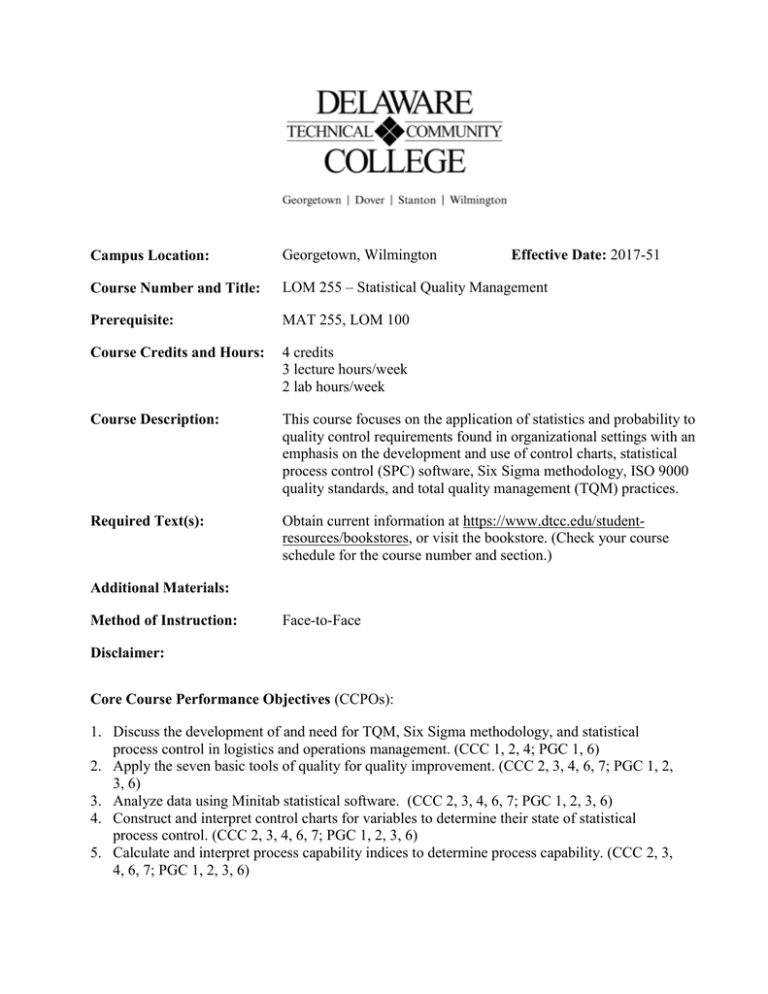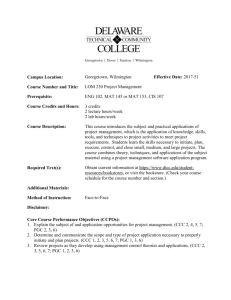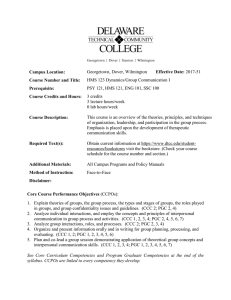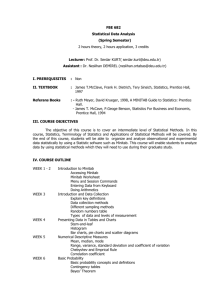3. Analyze data using Minitab statistical software. - E
advertisement

Campus Location: Georgetown, Wilmington Effective Date: 2017-51 Course Number and Title: LOM 255 – Statistical Quality Management Prerequisite: MAT 255, LOM 100 Course Credits and Hours: 4 credits 3 lecture hours/week 2 lab hours/week Course Description: This course focuses on the application of statistics and probability to quality control requirements found in organizational settings with an emphasis on the development and use of control charts, statistical process control (SPC) software, Six Sigma methodology, ISO 9000 quality standards, and total quality management (TQM) practices. Required Text(s): Obtain current information at https://www.dtcc.edu/studentresources/bookstores, or visit the bookstore. (Check your course schedule for the course number and section.) Additional Materials: Method of Instruction: Face-to-Face Disclaimer: Core Course Performance Objectives (CCPOs): 1. Discuss the development of and need for TQM, Six Sigma methodology, and statistical process control in logistics and operations management. (CCC 1, 2, 4; PGC 1, 6) 2. Apply the seven basic tools of quality for quality improvement. (CCC 2, 3, 4, 6, 7; PGC 1, 2, 3, 6) 3. Analyze data using Minitab statistical software. (CCC 2, 3, 4, 6, 7; PGC 1, 2, 3, 6) 4. Construct and interpret control charts for variables to determine their state of statistical process control. (CCC 2, 3, 4, 6, 7; PGC 1, 2, 3, 6) 5. Calculate and interpret process capability indices to determine process capability. (CCC 2, 3, 4, 6, 7; PGC 1, 2, 3, 6) 6. Construct and interpret control charts for attributes to determine their state of statistical control. (CCC 2, 3, 4, 6, 7; PGC 1, 2, 3, 6) 7. Describe product reliability measurement and failure mode and effect analysis (FMEA), and calculate series, parallel, and backup system reliabilities. (CCC 1, 2, 3, 4, 6, 7; PGC 1, 2, 3, 6) 8. Analyze, solve, and present a comprehensive statistical process control (SPC) case problem. (CCC 1, 2, 3, 4, 5, 6, 7, PGC 1, 2, 3, 6) See Core Curriculum Competencies and Program Graduate Competencies at the end of the syllabus. CCPOs are linked to every competency they develop. Measurable Performance Objectives (MPOs): Upon completion of this course, the student will: 1. Discuss the development of and need for TQM, Six Sigma methodology, and statistical process control in logistics and operations management. 1.1 Define quality from the viewpoint of the customer and the other major stakeholders in an organization. 1.2 Discuss variation and its effect on product and service quality. 1.3 Explain the evolution of quality from inspection to TQM. 1.4 Define the concepts of continual improvement and TQM. 1.5 Discuss the quality theories of various leaders in the field and the emergence of statistical process control as a continual improvement tool. 1.6 Explain the application of Six Sigma methodology for continual improvement of products and processes. 2. Apply the seven basic tools of quality for quality improvement. 2.1 2.2 2.3 2.4 Describe the key elements of the problem solving process. Discuss the seven tools of quality. Identify tools used for problem definition, data gathering, and root cause analysis. Apply the seven tools of quality improvement. 3. Analyze data using Minitab statistical software. 3.1 Arrange data and create histograms. 3.2 Explain measures of location (mean, median, and mode) and dispersion (range, standard deviation, and variance). 3.3 Describe skewness and kurtosis. 3.4 Contrast continuous versus discrete probability distributions. 3.5 Describe the normal and standard normal distributions. 3.6 Input sets of data into Minitab, and arrange them for statistical analysis. 3.7 Use Minitab tools to obtain descriptive statistics on data, and test data for normality. 4. Construct and interpret control charts for variables to determine their state of statistical control. 4.1 Define variables versus attributes data and rational subgrouping of data. 4.2 Explain the importance of the central limit theorem (CLT) in the development of variables control charts. 4.3 Describe special cause versus common cause variation. 4.4 Construct X-bar and R-charts manually using the Shewhart tables. 4.5 Input and arrange data in Minitab to construct X-bar and R-charts. 4.6 Apply the basic control chart rules for out-of-control conditions (3σ limits, runs, and trends) to determine the state of control of the control chart variable. 4.7 Identify other patterns of variation (automatic control, negative and positive autocorrelation, and overcorrection) in control charts. 4.8 Construct individuals and moving range charts and nominal X-bar and R-charts and describe the situations in which they are used. 5. Calculate and interpret process capability indices to determine process capability. 5.1 Define voice of the customer (VOC), and explain how product specification limits are created using VOC. 5.2 Describe the difference between process control limits (common cause variation) and product specification limits. 5.3 Identify and explain process capability and performance indices (Cp, Cpk, Cpm, Pp, Ppk). 5.4 Use Minitab statistical software to calculate process capability and process performance indices, and create capability analyses with histograms. 5.5 Interpret capability indices and histograms to determine if a process variable is capable. 6. Construct and interpret control charts for attributes to determine their state of statistical control. 6.1 Discuss the seven theorems of probabilities, and explain permutations versus combinations. 6.2 Describe the binomial and Poisson distributions as the basis for attributes control charts. 6.3 Construct and interpret p- and np-charts using Minitab software. 6.4 Construct and interpret c- and u-charts (fixed sample size) using Minitab software. 6.5 Construct and interpret p-, np-, and u-charts (varying sample size) using Minitab software. 6.6 Discuss the use of acceptance sampling for incoming quality inspection. 7. Describe product reliability measurement and failure mode and effect analysis (FMEA), and calculate series, parallel, and backup system reliabilities. 7.1 Define component versus system reliability and measurements of reliability (mean time between failure, mean time to failure). 7.2 Calculate the system reliability of series, parallel, and backup systems. 7.3 Describe failure mode and effect analysis and the three components that comprise Risk Priority Numbers (RPN). 8. Analyze, solve, and present a comprehensive statistical process control (SPC) case problem. 8.1 Enter and properly format the data in Minitab. 8.2 Obtain descriptive statistics on the data from Minitab tools. 8.3 Create control charts, process capability analyses, process Sixpacks, and stacked capability analyses using Minitab. 8.4 Draw astute conclusions regarding the state of process control and capability for the data sets analyzed. 8.5 Prepare and present a comprehensive case report in both Word and PowerPoint. Evaluation Criteria/Policies: Students must demonstrate proficiency on all CCPOs at a minimal 75 percent level to successfully complete the course. The grade will be determined using the DTCC grading system: 92 83 75 0 – – – – 100 91 82 74 = = = = A B C F Students should refer to the Student Handbook (https://www.dtcc.edu/academics/studenthandbook) for information on the Academic Standing Policy, the Academic Integrity Policy, Student Rights and Responsibilities, and other policies relevant to their academic progress. Core Curriculum Competencies (CCCs are the competencies every graduate will develop): 1. 2. 3. 4. 5. Communicate clearly and effectively both orally and in writing. Demonstrate effective problem solving and reasoning skills. Work effectively in groups of people from diverse backgrounds. Demonstrate ethical and professional understanding and conduct. Apply appropriate information literacy skills to locate, evaluate, and use information effectively. 6. Use computer technology appropriate to the field. 7. Use scientific and mathematical reasoning appropriate to the technology. Program Graduate Competencies (PGCs are the competencies every graduate will develop specific to his or her major): 1. Analyze logistics, supply chain, and operations processes in order to provide assistance in the development of quality, customer service, and cost improvement alternatives. 2. Utilize various statistical quality control techniques to aid in the development and utilization of global quality logistics, supply chain, manufacturing, and service applications. 3. Apply integrated technology-driven information necessary for logistics, supply chain and operations. 4. Perform cost analysis on proposed logistics, supply chain and operations projects and make data-driven investment recommendations to management. 5. Develop and optimize logistics and operations business processes, including job design and workplace layout. 6. Apply management functions, statistical quality and process applications, planning and scheduling techniques, and related software applications necessary for successful business decision making. 7. Apply managerial accounting, economics, human resources, and marketing principals when making workplace decisions.




